Whilst perusing Breton's dictionary, yet again, we saw that the Kalinago had words for the mixed-race children of Indian men and black women. The language also used Iábouloupou for the children of white men and black women. For black people in general, they seem to have used the word tibouloue. The Galibi on the South American mainland used the word tibourou for blacks. Thus, it seems like tibouloue is of Cariban rather than Arawakan origin. However, in Garifuna, the word wuriti is used for black. In Palikur, black is pohe or puhiye. In Wayuu, it can be rendered as mütsiiya or yuulii. The distant Ashaninka language has cheenkari for black. In Lokono, khareme seems to be the word for black, while in Suriname black people are called Dolhi.
However, one must determine if the same word for the black color was applied to people of African descent in the 1500s and 1600s for other Arawakan languages, like Taino. Since "Taino" people were the first to see and engage with Africans and mixed-race people of African descent, it is tempting to wonder if terms like Chibárali and cachionna could be of Taino origin. According to Breton, Chibárali was also used for a type of dangerous arrow. This is no surprise, since the word sounds somewhat close to simara, which was probably the Taino word for arrow (or something rather close to it) which, later on, became incorporated into the word for maroon in Spanish (and subsequently, other European languages). However, the term actually seems to be connected to the ray, an animal whose tail was used for a very deadly type of arrow. The mainland Caribs have a similar word for ray, although the Kalinago term for the arrow made using the ray sounds like a fusion of chimara and chibali. Was the use of this term for black-Indian people to express disdain or fear of the deadly nature of the mix?
It is fascinating how the Kalinago of the 17th century were using a word etymologically linked to arrows and rays to describe mixed-race Indian-black people. By the time Breton met and recorded their language, the Kalinago had already been interacting with Europeans and Africans for several decades. In addition, fleeing Taino speakers from Puerto Rico and likely other parts of the Greater Antilles were said to have sought refuge in the Lesser Antilles. Could these Taino speakers have introduced the meaning of Chimara as connotating half-black heritage? It's certainly possible given the earlier exposure of Taino speakers with Europeans and Africans and their own experiences or knowledge of marronage from Spanish colonial authorities in the 1500s. Intriguingly, the 17th century Kalinago, who were known for taking African slaves as captives and reselling some to Europeans, used another word for maroons or fugitive slaves, Anourouti or toüalicha. These terms seem to be of Cariban or non-Arawakan origin. One suspects the Kalinago also would have quickly gained familiarity with maroon in the sense it was used by Europeans.
The other term for half-black people, cachionna, could also be used for half-white, half-black peoples. It contains the Kalinago word for Sun but could also be related to a number of other words. It could also be related to a number of words in the Island Carib language referring to fruits, wood, young geese, or a type of manioc flour. Interestingly, cachi is similar to the word for Moon in a number of Arawakan languages, although Breton gives Moon as cati in his dictionary. Is it feasible for the Kalinago language to have used a word for Sun that sounds so similar to the word for Moon in other Arawakan languages? For example, Arawak in Suriname uses kathi for the Moon and adali for the Sun. Garifuna uses hati for Moon. In the language of the Wayuu, Kashi also meant Moon. Why was the Kalinago term for Sun so similar to the word for Moon? Did Breton make a mistake?
Although far more work remains to be done, we wonder if the general word for black people in Taino and the Arawakan-rooted words in Kalinago were similar, perhaps something like the Garifuna wuritti. Or perhaps something close to the Lokono khareme or Wayuu yuulii was used as a general term for dark-skinned black Africans. But was cachionna perhaps similar to a Taino term for mixed-race black-Indian peoples.


No comments:
Post a Comment